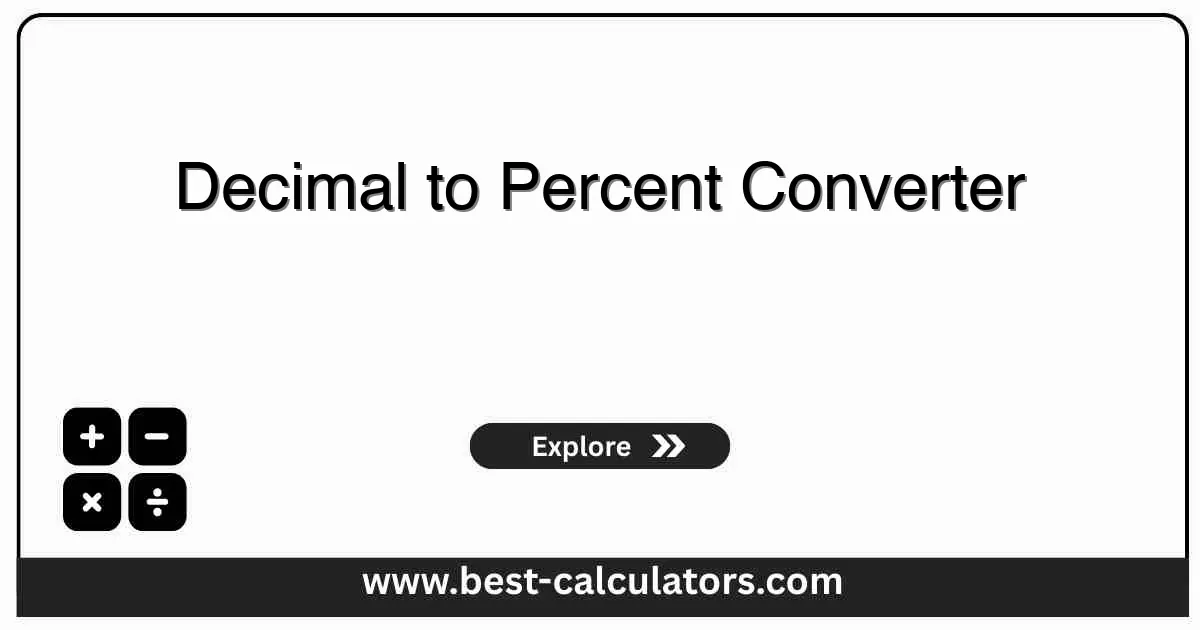Decimal to Percent Converter - Convert Decimals to Percentages
Easily convert any decimal number into its equivalent percentage. Enter a decimal to get instant results.
Decimal to Percent Converter
Result
What is a Decimal to Percent Converter?
A Decimal to Percent Converter is a free online tool designed to quickly and accurately transform any decimal number into its equivalent percentage. This converter is invaluable for anyone needing to express numerical values in a more universally understood and comparable format.
This tool is particularly beneficial for:
- Students - For mathematics homework, exams, and grasping the relationship between decimals and percentages.
- Professionals - In fields such as finance, data analysis, and retail, where quick conversions are often necessary.
- Everyday Users - When dealing with discounts, interest rates, or any situation requiring percentage understanding.
For calculating percentages directly, check out our Percentage Calculator to perform various percentage operations with ease.
If you need to find the average of multiple percentages, our Average Percentage Calculator is perfect for that purpose.
How This Converter Works
The conversion from a decimal to a percentage is straightforward and follows a simple mathematical rule:
The converter takes the decimal number you input, multiplies it by 100, and then appends the percent sign (%). For instance, if you input 0.75, the converter calculates 0.75 × 100 = 75%, displaying the result as "75%".
This process effectively shifts the decimal point two places to the right, making the number a percentage, which represents a fraction out of 100.
Key Concepts Explained
Decimals
Decimals are numbers that represent quantities that are not whole. They use a decimal point to separate the whole number part from the fractional part, where each digit after the decimal point represents a power of ten (tenths, hundredths, etc.).
Percentages
A percentage is a way of expressing a number or a ratio as a fraction of 100. It is often used to represent parts of a whole, increases, decreases, or proportions in a standardized and easily understandable format.
Conversion
Conversion, in this context, refers to the process of changing a numerical value from one form (decimal) to another (percentage) while preserving its underlying value. This allows for different representations of the same quantity.
How to Use This Converter
Enter Decimal
Input the decimal number you wish to convert (e.g., 0.75, 1.2, 0.05).
Click Convert
Press the 'Convert' button to instantly see the decimal transformed into a percentage.
Reset
Use the 'Reset' button to clear the input field and perform a new conversion.
Benefits of Using This Converter
- • Accuracy: Ensures precise conversions, eliminating potential manual calculation errors.
- • Efficiency: Provides instant results, saving time for quick checks or bulk conversions.
- • User-Friendly: Simple and intuitive interface makes it accessible for all users, regardless of mathematical proficiency.
- • Versatility: Handles a wide range of decimal values, from very small to large numbers.
Factors That Affect Your Results
1. Decimal Value
The magnitude of the decimal number directly determines the resulting percentage. A larger decimal will yield a larger percentage, and vice-versa.
2. Precision
The number of decimal places in your input can affect the precision of the output percentage. The converter will typically maintain a reasonable level of precision, but very long decimals might be rounded for display.
3. Input Format
Ensure the input is a valid numerical decimal. Non-numeric characters or incorrect formatting will result in an error or an inability to perform the conversion.

Frequently Asked Questions (FAQ)
Q: How do you convert a decimal to a percentage?
A: To convert a decimal to a percentage, multiply the decimal number by 100 and add a percent sign. For example, to convert 0.25 to a percentage, you would calculate 0.25 × 100 = 25%.
Q: What is a decimal?
A: A decimal is a number that includes a decimal point, separating the whole number part from the fractional part. It's a way of representing numbers that are not whole numbers.
Q: Can all decimals be converted to percentages?
A: Yes, any decimal number can be converted into a percentage. Percentages are simply a way of expressing a number as a fraction of 100, making them interchangeable with decimals through multiplication or division by 100.
Q: Why is it useful to convert decimals to percentages?
A: Converting decimals to percentages is useful for easier interpretation and comparison of data, especially in contexts like statistics, finance (e.g., interest rates), and everyday situations where proportions are often expressed as percentages.